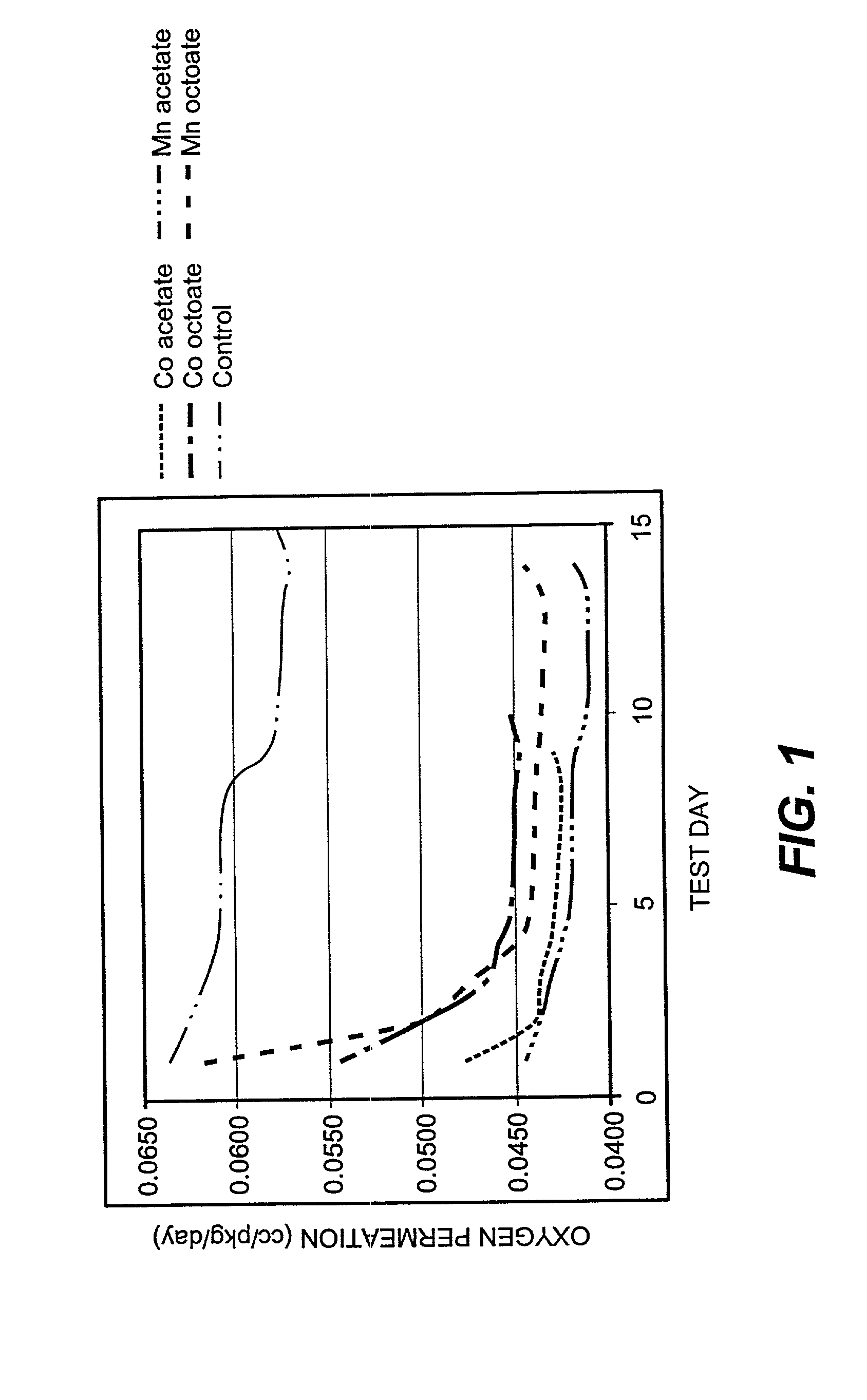Process for reduction of acetaldehyde and oxygen in beverages contained in polyester-based packaging
a technology of polyester-based packaging and acetaldehyde, which is applied in the field of packaging, can solve the problems of reducing the recycling efficiency of plastic containers, so as to reduce or eliminate the migration of acetaldehyde and reduce or eliminate the migration of oxygen
- Summary
- Abstract
- Description
- Claims
- Application Information
AI Technical Summary
Benefits of technology
Problems solved by technology
Method used
Image
Examples
example 1
[0036] 100 grams of cobalt octoate (12 wt % cobalt) was mixed with 100 grams of synthetic mineral oil. 20 grams of this mixture was coated onto 24 kg of dry PET pellets. The coated pellets where then fed to an Arburg unit cavity injection molding machine, running at 520.degree. F. 27 gram preforms were made with a 30 second cycle time. The preforms were blown into 20 oz containers, using a Sidel SBO-2 blower molder. The resulting bottles had 50 ppm cobalt (as Cobalt octoate).
[0037] Examples 2-6 are directed to the absorption of oxygen into PET containers comprising oxidation catalysts. The PET container of Example 2 was the control and contained no oxidation catalyst. Example 3 comprised 50 ppm of cobalt as cobalt acetate. Example 4 comprised 50 ppm of cobalt as cobalt octoate. The container of Example 5 comprised 50 ppm of manganese as manganese octoate, and Example 6 contained 50 ppm of manganese as manganese acetate.
[0038] In each example, the permeation rate of oxygen was determ...
example 7
[0042] The acetaldehyde concentration in preforms comprising varying amounts of oxidation catalysts was determined. Specifically, preforms comprising 10 ppm, 25 ppm, and 50 ppm of cobalt octoate and preforms comprising 10 ppm, 25 ppm, and 50 ppm of cobalt napthenate were tested. A preform comprising no oxidation catalyst was also tested as a control. To determine the acetaldehyde content in each preform, a portion of the preform was removed and chilled in liquid nitrogen. The preform sample was then ground to pass through a 2 mm screen. 0.100 grams of the granules were weighed into a 20 ml widemouth vial, and the vial was sealed with a teflon-lined crimp seal. The sample was then heated to 150.degree. C. for 45 minutes to volatize the acetaldehyde contained in the polymer granules. The amount of volatized acetaldehyde was quantitatively measured by injecting a known amount of the vial headspace into a gas chromatograph equipped with a flame-ionization detector. The detector response...
example 8
[0043] The following procedure was used to determine the acetaldehyde concentration in the headspace of PET containers. The bottles tested comprised various concentrations of oxidation catalysts. Specifically, bottles comprising 10 ppm, 25 ppm and 50 ppm of cobalt octoate and bottles comprising 10 ppm, 25 ppm and 50 ppm of cobalt naphthenate were tested. A control bottle comprising no oxidation catalyst was also tested. PET preforms were blow-molded using standard processing conditions. After each container had cooled to room temperature, the contents of the bottle was flushed with a stream of air, and the bottle was tightly capped with a standard lined closure. The bottle was then stored at 22.degree. C. for 24 hours. The amount of acetaldehyde that migrated from the sidewall to the interior of the bottle was then measured by taking a fixed amount of the air inside of the bottle, and performing standard GC analysis.
PUM
| Property | Measurement | Unit |
|---|---|---|
| cycle time | aaaaa | aaaaa |
| permeation | aaaaa | aaaaa |
| concentration | aaaaa | aaaaa |
Abstract
Description
Claims
Application Information
 Login to View More
Login to View More - R&D
- Intellectual Property
- Life Sciences
- Materials
- Tech Scout
- Unparalleled Data Quality
- Higher Quality Content
- 60% Fewer Hallucinations
Browse by: Latest US Patents, China's latest patents, Technical Efficacy Thesaurus, Application Domain, Technology Topic, Popular Technical Reports.
© 2025 PatSnap. All rights reserved.Legal|Privacy policy|Modern Slavery Act Transparency Statement|Sitemap|About US| Contact US: help@patsnap.com

